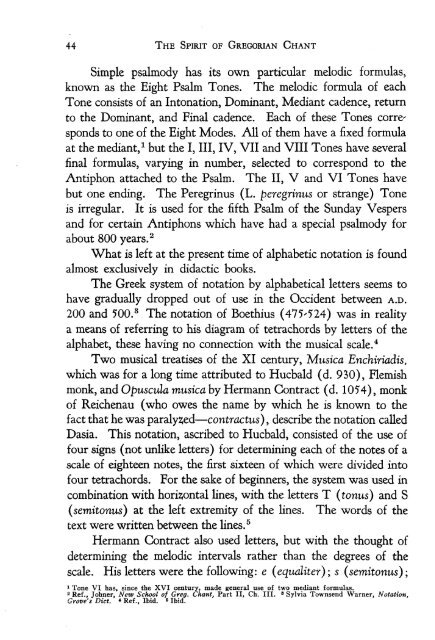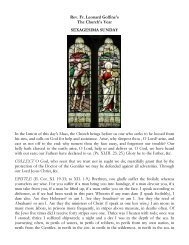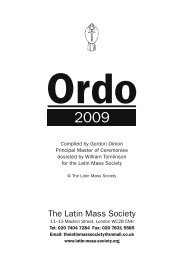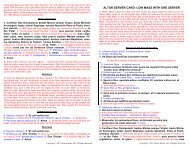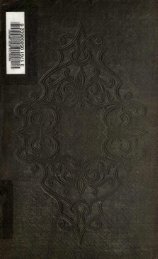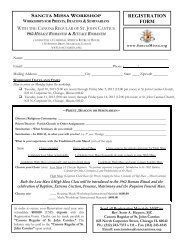The Spirit of Gregorian Chant - Church Music Association of America
The Spirit of Gregorian Chant - Church Music Association of America
The Spirit of Gregorian Chant - Church Music Association of America
Create successful ePaper yourself
Turn your PDF publications into a flip-book with our unique Google optimized e-Paper software.
44 THE SPIRIT OF GREGORIAN CHANT<br />
Simple psalmody has its own particular melodic formulas,<br />
known as the Eight Psalm Tones. <strong>The</strong> melodic formula <strong>of</strong> each<br />
Tone consists <strong>of</strong> an Intonation, Dominant, Mediant cadence, return<br />
to the Dominant, and Final cadence. Each <strong>of</strong> these Tones corresponds<br />
to one <strong>of</strong> the Eight Modes. All <strong>of</strong> them have a fixed formula<br />
at the mediant, 1 but the I, III, IV, VII and VIII Tones have several<br />
final formulas, varying in number, selected to correspond to the<br />
Antiphon attached to the Psalm. <strong>The</strong> II, V and VI Tones have<br />
but one ending. <strong>The</strong> Peregrinus (L. jperegrinus or strange) Tone<br />
is irregular. It is used for the fifth Psalm <strong>of</strong> the Sunday Vespers<br />
and for certain Antiphons which have had a special psalmody for<br />
about 800 years. 2<br />
What is left at the present time <strong>of</strong> alphabetic notation is found<br />
almost exclusively in didactic books.<br />
<strong>The</strong> Greek system <strong>of</strong> notation by alphabetical letters seems to<br />
have gradually dropped out <strong>of</strong> use in the Occident between A.D.<br />
200 and 500. 3 <strong>The</strong> notation <strong>of</strong> Boethius (475'524) was in reality<br />
a means <strong>of</strong> referring to his diagram <strong>of</strong> tetrachords by letters <strong>of</strong> the<br />
alphabet, these having no connection with the musical scale. 4<br />
Two musical treatises <strong>of</strong> the XI century, <strong>Music</strong>a Enchiriadis,<br />
which was for a long time attributed to Hucbald (d. 930), Flemish<br />
monk, and Opuscula musica by Hermann Contract (d. 1054), monk<br />
<strong>of</strong> Reichenau (who owes the name by which he is known to the<br />
fact that he was paralysed—contractus), describe the notation called<br />
Dasia. This notation, ascribed to Hucbald, consisted <strong>of</strong> the use <strong>of</strong><br />
four signs (not unlike letters) for determining each <strong>of</strong> the notes <strong>of</strong> a<br />
scale <strong>of</strong> eighteen notes, the first sixteen <strong>of</strong> which were divided into<br />
four tetrachords. For the sake <strong>of</strong> beginners, the system was used in<br />
combination with horizontal lines, with the letters T (tonus) and S<br />
(semitonus) at the left extremity <strong>of</strong> the lines. <strong>The</strong> words <strong>of</strong> the<br />
text were written between the lines. 5<br />
Hermann Contract also used letters, but with the thought <strong>of</strong><br />
determining the melodic intervals rather than the degrees <strong>of</strong> the<br />
scale. His letters were the following: e (equditer); s (semitonus);<br />
1 Tone VI has, since the XVI century, made general use <strong>of</strong> two mediant formulas.<br />
2 Ref., Johner, New School <strong>of</strong> Greg. <strong>Chant</strong>, Part II, Ch. III.<br />
s Sylvia Townsend Warner, Notation,<br />
Grove's Diet. * Ref., Ibid.<br />
5 Ibid.


